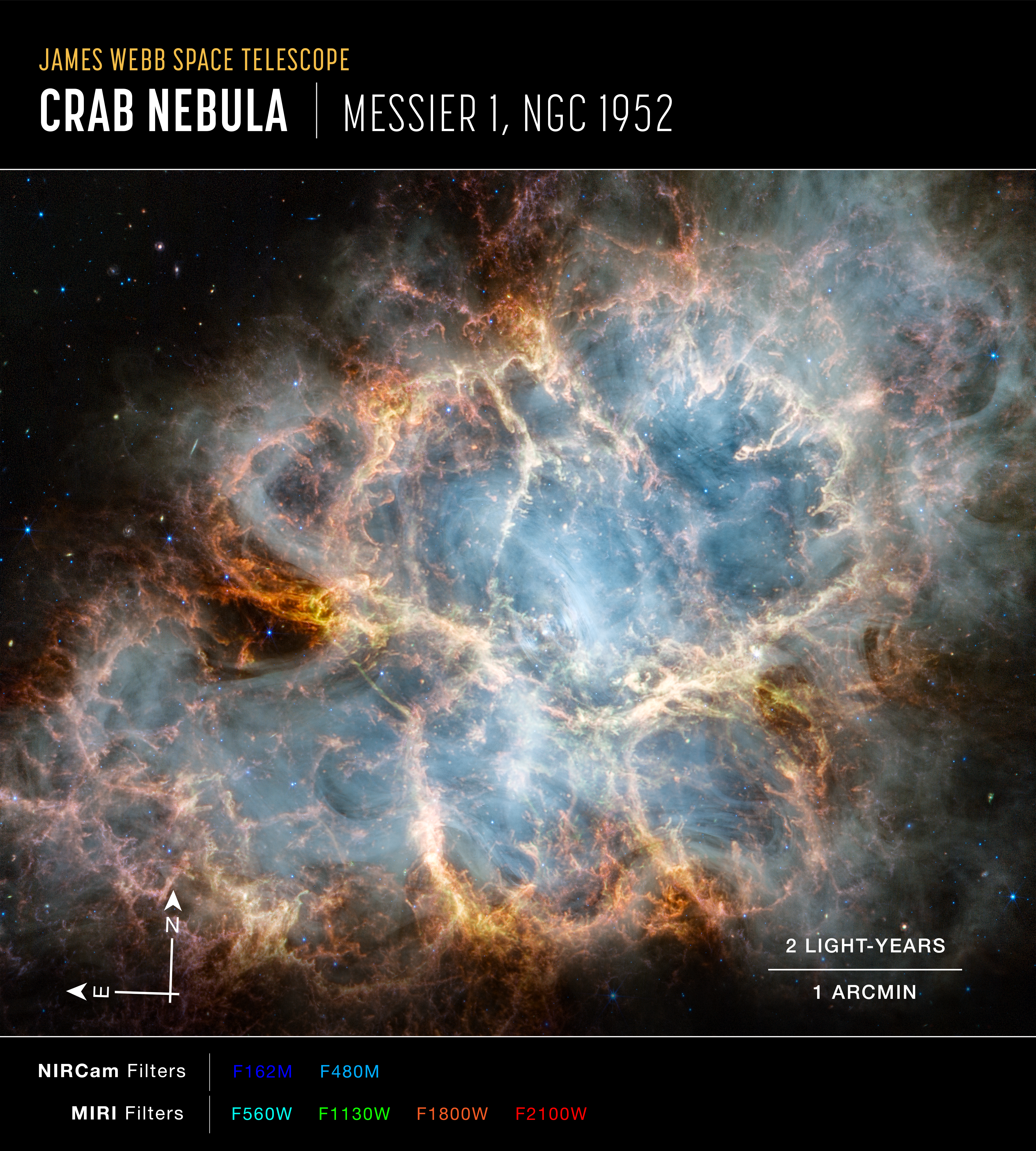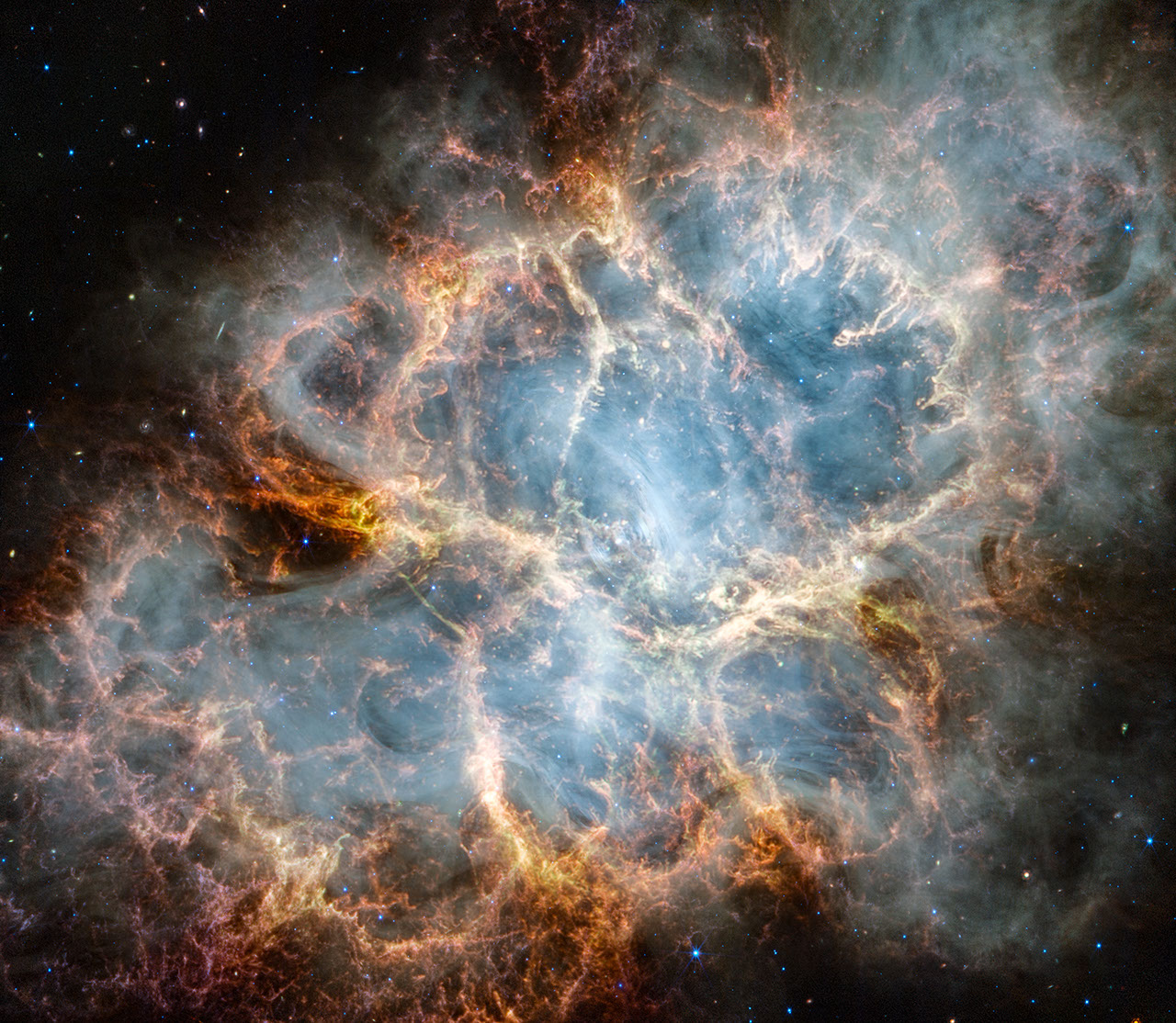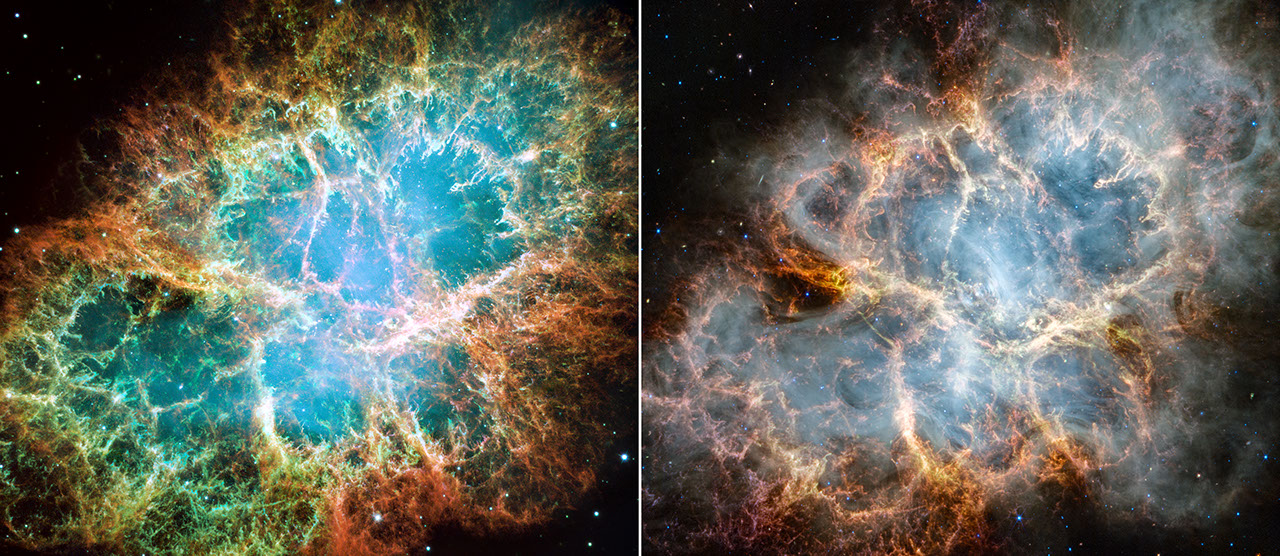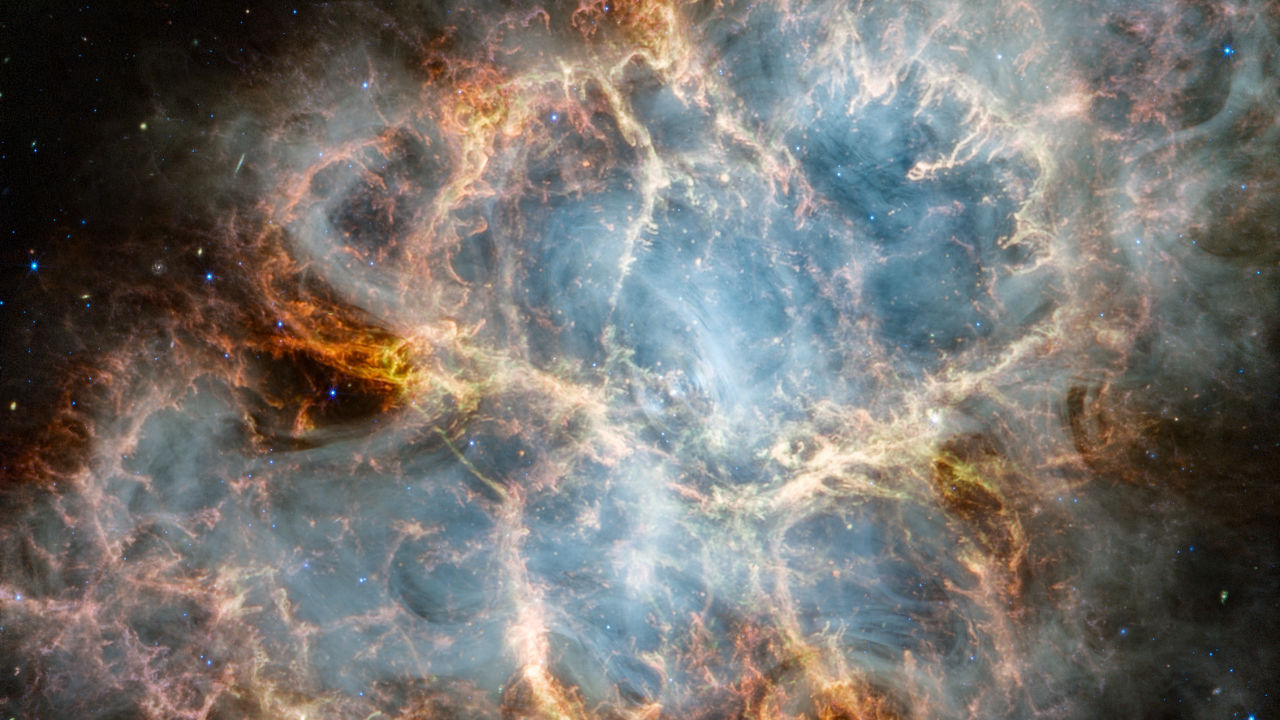1 min read
Crab Nebula (NIRCam and MIRI Compass Image)

Image of the Crab Nebula captured by Webb’s NIRCam and MIRI, with compass arrows, scale bar, and color key for reference.
The north and east compass arrows show the orientation of the image on the sky. Note that the relationship between north and east on the sky (as seen from below) is flipped relative to direction arrows on a map of the ground (as seen from above).
The scale bar is labeled in light-years, which is the distance that light travels in one Earth-year. (It takes 2 years for light to travel a distance equal to the length of the bar.) One light-year is equal to about 5.88 trillion miles or 9.46 trillion kilometers. The field of view shown in this image is approximately 10 light-years across.
This image shows invisible near-infrared and mid-infrared wavelengths of light that have been translated into visible-light colors. The color key shows which NIRCam and MIRI filters were used when collecting the light. The color of each filter name is the visible light color used to represent the infrared light that passes through that filter.
Extended Description and Image Alt Text
Extended Description
Image titled “James Webb Space Telescope, Crab Nebula, Messier I, NGC 1952” with compass arrows, scale bar, and color key.
Image
The Crab Nebula. An oval nebula with complex structure against a black background. On the nebula’s exterior, particularly at the top left and bottom left, lie curtains of glowing red and orange fluffy material. Its interior shell shows large-scale loops of mottled filaments of yellow-white and green, studded with clumps and knots. Translucent thin ribbons of smoky white lie within the remnant’s interior, brightest toward its center. The white material follows different directions throughout, including sometimes sharply curving away from certain regions within the remnant. A faint, wispy ring of white material encircles the very center of the nebula. Around and within the supernova remnant are many points of blue, red, and yellow light.
Compass Arrows, Scale Bar, and Color Key
At the bottom left are compass arrows indicating the orientation of the image on the sky. The north arrow points in the 12 o’clock direction. The east arrow points toward 9 o’clock. At the lower right is a scale bar labeled 2 light-years, 1 arcmin. The length of the scale bar is one-fifth the total width of the image. Below the image is a color key showing which NIRCam and MIRI filters were used to create the image and which visible-light color is assigned to each filter. From left to right, NIRCam filters are: F162M is blue; and F480M is light blue. From left to right, MIRI filters are: F560W is cyan; F1130W is green; F1800W is orange; and F2100W is red.
Image Alt Text
The Crab Nebula. An oval nebula with complex structure against a black background. At the bottom left are compass arrows indicating the orientation of the image on the sky.
About the Object
- R.A. PositionR.A. PositionRight ascension – analogous to longitude – is one component of an object's position.05:34:32
- Dec. PositionDec. PositionDeclination – analogous to latitude – is one component of an object's position.+22:00:52
- ConstellationConstellationOne of 88 recognized regions of the celestial sphere in which the object appears.Taurus
- DistanceDistanceThe physical distance from Earth to the astronomical object. Distances within our solar system are usually measured in Astronomical Units (AU). Distances between stars are usually measured in light-years. Interstellar distances can also be measured in parsecs.6500 light-years
- DimensionsDimensionsThe physical size of the object or the apparent angle it subtends on the sky.Image is about 5.5 arcmin across (about 10 light-years)
About the Data
- Data DescriptionData DescriptionProposal: A description of the observations, their scientific justification, and the links to the data available in the science archive.
Science Team: The astronomers who planned the observations and analyzed the data. "PI" refers to the Principal Investigator.This image was created with Webb data from proposal: 1714 (T. Temim) - Image Processing: Joseph DePasquale (STScI)
- InstrumentInstrumentThe science instrument used to produce the data.NIRCam, MIRI
- Exposure DatesExposure DatesThe date(s) that the telescope made its observations and the total exposure time.31 Oct 2022, 24 Feb 2023, 17 Mar 2023
- FiltersFiltersThe camera filters that were used in the science observations.NIRCam: F162M, F480M; MIRI: F560W, F1130W, F1800W, F2100W
- Object NameObject NameA name or catalog number that astronomers use to identify an astronomical object.Crab Nebula, M1, NGC 1952
- Object DescriptionObject DescriptionThe type of astronomical object.Supernova Remnant, Pulsar
- Release DateOctober 30, 2023
- Science ReleaseThe Crab Nebula Seen in New Light by NASA’s Webb
- CreditImage: NASA, ESA, CSA, STScI, Tea Temim (Princeton University)

This image is a composite of separate exposures acquired by the James Webb Space Telescope using the NIRCam and MIRI instruments. Several filters were used to sample specific wavelength ranges. The color results from assigning different hues (colors) to each monochromatic (grayscale) image associated with an individual filter. In this case, the assigned colors are: Blue: F162M, Light Blue: F480M, Cyan: F560W, Green: F1130W, Orange: F1800W, Red: F2100W
Related Images & Videos

Crab Nebula (NIRCam and MIRI Image)
NASA’s James Webb Space Telescope has gazed at the Crab Nebula in the search for answers about the supernova remnant’s origins. Webb’s NIRCam (Near-Infrared Camera) and MIRI (Mid-Infrared Instrument) have revealed new details in infrared light. Similar to the Hubble optical...

Crab Nebula (Webb and Hubble Comparison)
A side-by-side comparison of the Crab Nebula as seen by the Hubble Space Telescope in optical light (left) and the James Webb Space Telescope in infrared light (right). The Hubble image was released in 2005, while astronomers have recently used Webb’s NIRCam (Near-Infrared...
Share
Details
Laura Betz
NASA’s Goddard Space Flight Center
Greenbelt, Maryland
laura.e.betz@nasa.gov
NASA, ESA, CSA, STScI, Tea Temim (Princeton University)
































